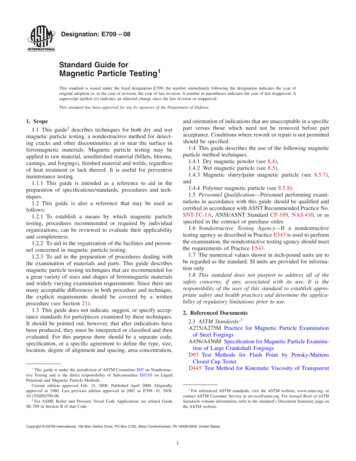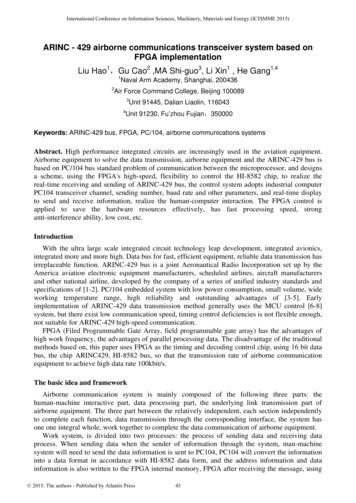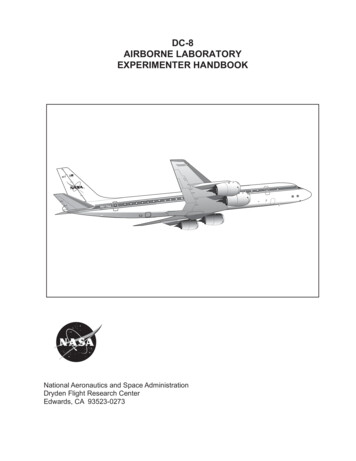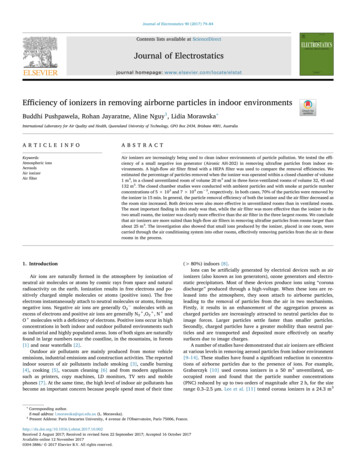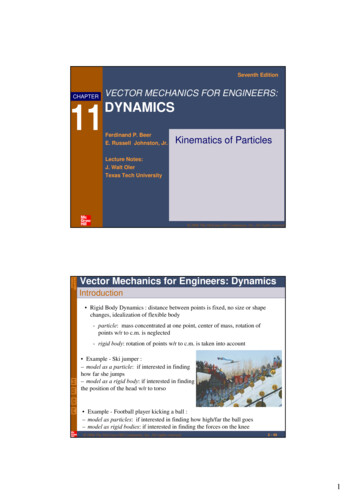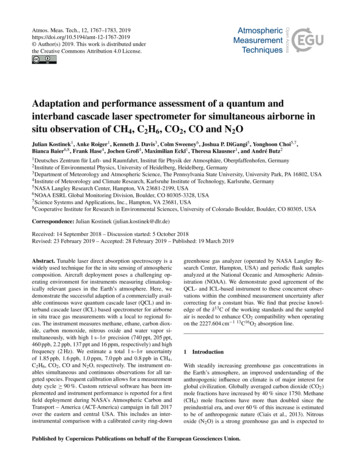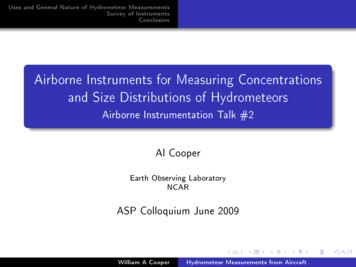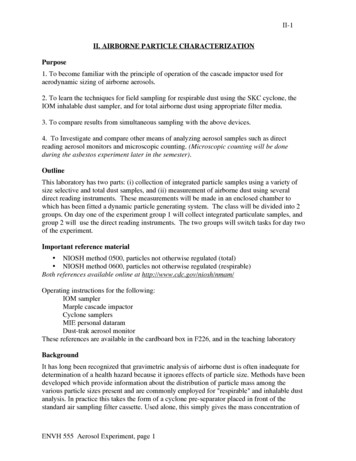
Transcription
II-1II. AIRBORNE PARTICLE CHARACTERIZATIONPurpose1. To become familiar with the principle of operation of the cascade impactor used foraerodynamic sizing of airborne aerosols.2. To learn the techniques for field sampling for respirable dust using the SKC cyclone, theIOM inhalable dust sampler, and for total airborne dust using appropriate filter media.3. To compare results from simultaneous sampling with the above devices.4. To Investigate and compare other means of analyzing aerosol samples such as directreading aerosol monitors and microscopic counting. (Microscopic counting will be doneduring the asbestos experiment later in the semester).OutlineThis laboratory has two parts: (i) collection of integrated particle samples using a variety ofsize selective and total dust samples, and (ii) measurement of airborne dust using severaldirect reading instruments. These measurements will be made in an enclosed chamber towhich has been fitted a dynamic particle generating system. The class will be divided into 2groups. On day one of the experiment group 1 will collect integrated particulate samples, andgroup 2 will use the direct reading instruments. The two groups will switch tasks for day twoof the experiment.Important reference material NIOSH method 0500, particles not otherwise regulated (total) NIOSH method 0600, particles not otherwise regulated (respirable)Both references available online at http://www.cdc.gov/niosh/nmam/Operating instructions for the following:IOM samplerMarple cascade impactorCyclone samplersMIE personal dataramDust-trak aerosol monitorThese references are available in the cardboard box in F226, and in the teaching laboratoryBackgroundIt has long been recognized that gravimetric analysis of airborne dust is often inadequate fordetermination of a health hazard because it ignores effects of particle size. Methods have beendeveloped which provide information about the distribution of particle mass among thevarious particle sizes present and are commonly employed for "respirable" and inhalable dustanalysis. In practice this takes the form of a cyclone pre-separator placed in front of thestandard air sampling filter cassette. Used alone, this simply gives the mass concentration ofENVH 555 Aerosol Experiment, page 1
II-2dust whose particle sizes are small enough to pass through the cyclone; no information aboutthe larger dust particles, or about the actual size distribution, is obtained.A more sophisticated type of instrument, the cascade impactor, can provide more detail on theparticle size distribution and can also be used to estimate the fraction (or concentration) ofrespirable dust present in the air. Its principle of operation, and the manipulation of primarydata from it, are described in the references.The inhalable dust sampler (IOM) collects a larger size distribution and corresponds to theACGIH sampling criteria for inhalable particulate mass.In this experiment you will take simultaneous samples with the cascade impactor, therespirable dust filter sampling train, the inhalable sampler and the total dust sampling train inorder to compare and interpret their results. Further, duplicate systems will be used for thedifferent techniques to gain insight into the extent of variability which is inherent in the filtersampling methods.Finally, it is important to realize that different filter media are required, dictated by thedifferent samplers that are used or the analysis method that will be applied to each sample.You should become familiar with which filter media are appropriate for specific applications.PART 1: Integrated Sampling for ParticulatesThe following table summarizes the different integrated samples that will be collected in thisexperiment. In addition to the samples listed below, you should prepare a lab blank for eachsampler configuration.Sample typeTotal dustSamplerFilter media# samplesCassette, closed facePVC1Cassette, open facePVC1Cassette, open faceMCE*1Inhalable dustIOMPVC1Respirable dustCyclone/cassettePVC2Size distributionMarpleMylar/PVC1 (6 stages)* The MCE samples will be used for microscopy and metals analysis. These filters do notneed to be weighed.ProcedureEach type of sampler must be carefully prepared. For gravimetric analysis, the filters or foilsmust be accurately weighed before and after sampling using identical equilibration techniquesthat are described in the NIOSH Manual or as modified by the instructors. The techniquesmust take into account the effect of moisture and temperature on the sample media. You mustbegin this experiment by reading the manual or NIOSH method for each type of sampler toestablish what type of filter is required for each application.ENVH 555 Aerosol Experiment, page 2
II-31. Obtain Tare Weightsa. (Marple Impactor) Weigh the plastic collection foil for each preceding impactor plate andthe final filter on the microbalance. Filters should be weighted to constant weight. Be certainthat each train is reassembled exactly as it was calibrated or as numbered and that filters orplates are not exchanged. Slots and jets must be staggered.b. (Cassettes) Weigh the filters for the cassettes (including blank filters).c. Number all samplers for later identification. Be sure to record the tare weights along withthe matching sampler numbers.2. Cascade Impactor Set Up; Model 190 Marple Personal Cascade Impactora. Each collecting plate should be topped with a pre-weighed mylar foil. These are extremelythin. Use only one foil per stage (not the white spacers). For sampling dry dusts the samplingsubstrate must be coated with adhesive, but in this case, the aerosol is moist and an adhesiveis not required. The foils can pick up an electrostatic charge that must be neutralized bypassing them over an anti static device just before weighing. Care must be taken to keep thefilms in the proper sequence, as related to each impactor stage.b. Assemble the impactor as shown in the manual, inserting one pre-weighed foil per plate orstage. Include a 34 mm PVC absolute filter on the last stage. Connect it to the vacuum pump.Note that the corresponding media follows and is underneath the impactor stage.c. Adjust the flow rate through the sampler to 3 LPM as specified in the description using anappropriate calibration device. Note that the absolute particle-size cut-point for each stage ofthe impactor is determined by the flow rate through the impactor. A flow of 3L/minute willallow collection of sufficient mass in the 2-hr sampling period for subsequent accurategravimetic analysis. The Marple manual describes how to calculate the mass cut-points at 3L/minute flow rate.3. Filter and Cyclone/Filter Sampling Train Set Upa. Using 37 mm polystyrene cassettes and pre-weighed PVC filters, assemble two respirableand two total dust sampling trains. Follow the steps outlined in the NIOSH Methods 0500 and0600. Also, fill cassettes with unweighed MCE filters for microscopic tests.b. Adjust the flow rate through each train to the specified value (that is 2.75 LPM for SKCcyclones) using an appropriate calibration device. Use a glass dessicator to calibrate pumpflow for the cyclones.c. The PVC filters will be used for gravimetric analysis and MCE will be retained formicroscopic size analysis and metals analysis in later lab experiments.4. IOM Inhalable Dust Samplersa. Assemble the sampling cassettes (1 metal, 1 plastic) with their filters. Carefully weigh thewhole cassette on the Mettler electrobalance. Place it in the sampler housing and attach thecover. NB: It may help to preweigh the IOMs on the top-loading balance in the main lab, andENVH 555 Aerosol Experiment, page 3
II-4use this approximate weight as a starting point for obtaining an exact weight on the Mettlerelectrobalance.b. Use the adapter and calibrate the flow to 2 LPM.5. Aerosol Generation and Samplinga. The zinc and iron salt aerosol will be generated using a nebulizer and aerosol dilutionsystem. Observe and make a diagram of the generator and chamber assembly. Note thelocation of the sampling ports and the respective sampler locations in the chamber.b. Place and record the location of the cascade impactor, the respirable and inhalablesamplers, and total dust filters inside the chamber. Attach each to the appropriate tubingthrough-ports provided to the correct pumps. Be sure each sampler is properly oriented in thechamber air flow. Close and seal the chamber.c. The nebulizer flow is adjusted to preset conditions for optimum generation of the aerosol.The build up of aerosol to uniform concentration can be followed with the MIE personaldataram and the beam of the laser pen. Other Aerosol Monitors, such as the Dust-trak will beavailable.d. Once the aerosol has reached uniform distribution in the chamber, start the varioussamplers and sample for approximately 1-2 hours or a period designated by the instructor.e. When sampling is complete, shut off each sampler, recording the sampling time andflow. The generator must be turned off and the chamber cleared before the samplers can beremoved.6. Determine gross weightsa. Remove the samplers and disassemble each sampler carefully. Allow the filters toequilibrate in the dessicator provided ( 1hr). After equilibration, weigh to constant weightand record the weights as before in Section 1.b. Mark and retain the samplers (cassettes) that were designated for later microscopicand metals analysis. Place these samplers in a safe location.7. Calculations and Application of Data:a. Tabulate the size selective data for the Marple cascade samplers and calculate thefollowing according to the procedures in the Marple brochure:I. Using computer software (e.g Microsoft excel), graph the differential particle sizedistribution size distribution as described in the marple manual. Use logarithmicscales for both axes.II. Using computer software (e.g Microsoft excel), graph the cumulative particle sizedistribution size distribution as described in the marple manual. Use a logarithmicscale for the particle size axis.ENVH 555 Aerosol Experiment, page 4
II-5i. From this cumulative particle size distribution graph, determine the MassMedian Aerodynamic Diameter (MMAD).ii. From the cumulative particle size distribution graph, determine theGeometric Standard Deviation (GSD).b. Use the cascade impactor data to calculate the fraction of the aerosol that was respirable.c. Calculate the concentration of respirable dust from cyclone data, and the concentration ofthe total dust from the open faced filter samplers. Then calculate the fraction of respirabledust from the ratio of the respirable dust from the cyclone samplers to the weight of the totaldust from the open faced filters.d. Compare the respirable fraction as calculated from both b. and c. Should the result fromthe two different methods agree? Discuss why you feel these results are or are notcomparable.Questions:a. Is the total concentration greater than the respirable concentration?b. Does the sum of the weights of all the Marple stages give the same total dustconcentration as the total dust samplers?c. How does the IOM data compare to the other size fractions? Is it less than the total? Is itgreater than the respirable? Is this what general principles would predict?ENVH 555 Aerosol Experiment, page 5
II-6PART 2: Direct Aerosol Measurement LabIn this part of the experiment, you will use the following direct reading instruments to monitorparticle levels in real time:Dust-trakMIE personal dataram (pDR)Procedure1. Operation:Read the operating instruction for each manual, and determine how to execute thefollowing operations. (Check with the instructors if in doubt).a.b.c.d.On/offZero instrumentMeasure particle levelsStore and download data to computer.2. Measurement Locations:a. Sampling ports on chamberb. Chamber exhaust3. Particle Measurements:a. The dust-trak and the personal dataram should be set up to log the PM data at 1minute intervals. Connect the dataram to a sampling port and commence samplingco-incident with the integrated samples collected by group 1. Later, we willcompare the integrated TWA measurement from the data ram with the gravimetricmass measurement from the filter samples.b. Using the dust-trak:1. Perform side-by-side comparisons of the two instruments. Do they reportthe same levels?2. Compare measurements made with and without the size selective inlet.To what extent does the size selective inlet attenuate instrumentresponse?4. Reporting Data:a. Download the data from the dataram and dust-trak to Microsoft excel. (Follow theinstructions in the manual. Ask an instructor if you have problems). Generate agraph of particle level vs. time. Annotate the graphs as appropriate to indicatechanges in sampler position, size selective inlets, etc.b. Prepare data tables to summarize the measurements made in part 3 (above)c. Share your data with the other group. How does the data from the dust-trakcompare with the mass measurements from the cyclones?d. Remember to answer the questions highlighted in the text in the previous sectionsENVH 555 Aerosol Experiment, page 6
II-7Write Up (for parts I and II combined)1. Include all data obtained in Part I, 6 & 7, and Part II 3 & 42. Answer all the questions that were highlighted in Part I, #7, and Part II #3 & 43. Compare the results from the various monitoing methods with respect to estimatedrespirable fraction and agreement on total mass concentration. Prepare a brief summary table.4. Discuss the advantages and disadvantages of each of the techniques. In what circumstanceswould each technique be most appropriate? What situations would require the use of multiplesampling techniques vs. one particular technique?Supplementary References:1. Cohen, B. Air Sampling Instruments, ACGIH, 8th Edition. Chapters 13, 14, 16 (1995).2. NIOSH. The Industrial Environment - Its Evaluation and Control. Chapter 14.3. Mercer, T.T. Aerosol Technology in Hazard Evaluation. New York: Academic Press,1973.4. Raabe, O. Size-selective sampling criteria for thoracic and respirable mass fractions. Trans.A.C.G.I.H. 1984, p. 53.5. Hinds, W. C., Aerosol Technology, Wiley Interscience, New York, 19826. Perkins, Jimmy. Modern Industrial Hygiene, Recognition and Evaluation of ChemicalAgents, Chapter 22, Van Nostrand Reinhold, 1997.ENVH 555 Aerosol Experiment, page 7
PARTICULATES NOT OTHERWISE REGULATED, TOTALDEFINITION: total aerosol massMETHOD: 0500, Issue 2CAS: NONERTECS: NONEEVALUATION: FULLOSHA : 15 mg/m 3NIOSH: no RELACGIH: 10 mg/m 3, total dust less than1% quartz0500Issue 1: 15 February 1984Issue 2: 15 August 1994PROPERTIES:contains no asbestos and quartzless than 1%SYNONYMS: nuisance dusts; particulates not otherwise classifiedSAMPLINGSAMPLER:FILTER(tared 37-mm, 5-µm PVC filter)FLOW RATE:1 to 2 L/minVOL-MIN:-MAX:7 L @ 15 mg/m 3133 L @ 15 mg/m S:2 to 10 field blanks per setBULKSAMPLE:none requiredMEASUREMENTTECHNIQUE:GRAVIMETRIC (FILTER WEIGHT)ANALYTE:airborne particulate materialBALANCE:0.001 mg sensitivity;use same balance before and aftersample collectionCALIBRATION:National Institute of Standards andTechnology Class S-1.1 weights orASTM Class 1 weightsRANGE:0.1 to 2 mg per sampleESTIMATED LOD:0.03 mg per samplePRECISION (Sr):0.026 [2]ACCURACYRANGE STUDIED:8 to 28 mg/m 3BIAS:0.01%OVERALL PRECISION (ŜrT): 0.056 [1]ACCURACY: 11.04%APPLICABILITY: The working range is 1 to 20 mg/m 3 for a 100-L air sample. This method is nonspecific and determines thetotal dust concentration to which a worker is exposed. It may be applied, e.g., to gravimetric determination of fibrous glass [3]in addition to the other ACGIH particulates not otherwise regulated [4].INTERFERENCES: Organic and volatile particulate matter may be removed by dry ashing [3].OTHER METHODS: This method is similar to the criteria document method for fibrous glass [3] and Method 5000 for carbonblack. This method replaces Method S349 [5]. Impingers and direct-reading instruments may be used to collect total dustsamples, but these have limitations for personal sampling.NIOSH Manual of Analytical Methods (NMAM), Fourth Edition, 8/15/94
PARTICULATES NOT OTHERWISE REGULATED, TOTAL: METHOD 0500, Issue 2, dated 15 August 1994 - Page 2 of 3EQUIPMENT:1. Sampler: 37-mm PVC, 2- to 5-µm pore size membrane or equivalent hydrophobic filter andsupporting pad in 37-mm cassette filter holder.2. Personal sampling pump, 1 to 2 L/min, with flexible connecting tubing.3. Microbalance, capable of weighing to 0.001 mg.4. Static neutralizer: e.g., Po-210; replace nine months after the production date.5. Forceps (preferably nylon).6. Environmental chamber or room for balance (e.g., 20 C 1 C and 50% 5% RH).SPECIAL PRECAUTIONS: None.PREPARATION OF FILTERS BEFORE SAMPLING:1.2.3.4.Equilibrate the filters in an environmentally controlled weighing area or chamber for at least 2 h.NOTE: An environmentally controlled chamber is desirable, but not required.Number the backup pads with a ballpoint pen and place them, numbered side down, in filtercassette bottom sections.Weigh the filters in an environmentally controlled area or chamber. Record the filter tare weight,W 1 (mg).a. Zero the balance before each weighing.b. Handle the filter with forceps. Pass the filter over an antistatic radiation source. Repeat thisstep if filter does not release easily from the forceps or if filter attracts balance pan. Staticelectricity can cause erroneous weight readings.Assemble the filter in the filter cassettes and close firmly so that leakage around the filter willnot occur. Place a plug in each opening of the filter cassette. Place a cellulose shrink bandaround the filter cassette, allow to dry and mark with the same number as the backup pad.SAMPLING:5.6.Calibrate each personal sampling pump with a representative sampler in line.Sample at 1 to 2 L/min for a total sample volume of 7 to 133 L. Do not exceed a total filterloading of approximately 2 mg total dust. Take two to four replicate samples for each batch offield samples for quality assurance on the sampling procedure.SAMPLE PREPARATION:7.8.9.Wipe dust from the external surface of the filter cassette with a moist paper towel to minimizecontamination. Discard the paper towel.Remove the top and bottom plugs from the filter cassette. Equilibrate for at least 2 h in thebalance room.Remove the cassette band, pry open the cassette, and remove the filter gently to avoid loss ofdust.NOTE: If the filter adheres to the underside of the cassette top, very gently lift away by usingthe dull side of a scalpel blade. This must be done carefully or the filter will tear.CALIBRATION AND QUALITY CONTROL:10.Zero the microbalance before all weighings. Use the same microbalance for weighing filtersbefore and after sample collection. Maintain and calibrate the balance with National Institute ofStandards and Technology Class S-1.1 or ASTM Class 1 weights.NIOSH Manual of Analytical Methods (NMAM), Fourth Edition, 8/15/94
PARTICULATES NOT OTHERWISE REGULATED, TOTAL: METHOD 0500, Issue 2, dated 15 August 1994 - Page 3 of 311.The set of replicate samples should be exposed to the same dust environment, either in alaboratory dust chamber [7] or in the field [8]. The quality control samples must be taken withthe same equipment, procedures and personnel used in the routine field samples. The relativestandard deviation calculated from these replicates should be recorded on control charts andaction taken when the precision is out of control [7].MEASUREMENT:12.Weigh each filter, including field blanks. Record the post-sampling weight, Wanything remarkable about a filter (e.g., overload, leakage, wet, torn, etc.)2(mg). RecordCALCULATIONS:13.Calculate the concentration of total particulate, C (mg/m3), in the air volume sampled, V (L):where: W 1 tare weight of filter before sampling (mg)W 2 post-sampling weight of sample-containing filter (mg)B1 mean tare weight of blank filters (mg)B2 mean post-sampling weight of blank filters (mg)EVALUATION OF METHOD:Lab testing with blank filters and generated atmospheres of carbon black was done at 8 to 28 mg/m[2,6]. Precision and accuracy data are given on page 0500-1.3REFERENCES:[1][2][3][4][5][6][7][8]NIOSH Manual of Analytical Methods, 3rd ed., NMAM 5000, DHHS (NIOSH) Publication No.84-100 (1984).Unpublished data from Non-textile Cotton Study, NIOSH/DRDS/EIB.NIOSH Criteria for a Recommended Standard . Occupational Exposure to Fibrous Glass, U.S.Department of Health, Education, and Welfare, Publ. (NIOSH) 77-152, 119-142 (1977).1993-1994 Threshold Limit Values and Biological Exposure Indices, Appendix D, ACGIH,Cincinnati, OH (1993).NIOSH Manual of Analytical Methods, 2nd ed., V. 3, S349, U.S. Department of Health,Education, and Welfare, Publ. (NIOSH) 77-157-C (1977).Documentation of the NIOSH Validation Tests, S262 and S349, U.S. Department of Health,Education, and Welfare, Publ. (NIOSH) 77-185 (1977).Bowman, J.D., D.L. Bartley, G.M. Breuer, L.J. Doemeny, and D.J. Murdock. Accuracy CriteriaRecommended for the Certification of Gravimetric Coal Mine Dust Personal Samplers. NTISPub. No. PB 85-222446 (1984).Breslin, J.A., S.J. Page, and R.A. Jankowski. Precision of Personal Sampling of RespirableDust in Coal Mines, U.S. Bureau of Mines Report of Investigations #8740 (1983).METHOD REVISED BY:Jerry Clere and Frank Hearl, P.E., NIOSH/DRDS.NIOSH Manual of Analytical Methods (NMAM), Fourth Edition, 8/15/94
PARTICULATES NOT OTHERWISE REGULATED, RESPIRABLEDEFINITION: aerosol collected by sampler with4-!m median cut pointMETHOD: 0600, Issue 3EVALUATION: FULLPROPERTIES:OSHA : 5 mg/m3NIOSH: no RELACGIH: 3 mg/m3SYNONYMS:CAS: NoneRTECS: NoneIssue 1: 15 February 1984Issue 3: 15 January 1998contains no asbestos and quartz less than1%; penetrates non-ciliated portions ofrespiratory systemnuisance dusts; particulates not otherwise classifiedSAMPLINGSAMPLER:0600MEASUREMENTCYCLONE FILTER(10-mm nylon cyclone, Higgins-Dewell [HD]cyclone, or Aluminum cyclone tared 5-!mPVC membrane)TECHNIQUE:GRAVIMETRIC (FILTER WEIGHT)ANALYTE:mass of respirable dust fractionBALANCE:0.001 mg sensitivity; use same balancebefore and after sample collectionCALIBRATION:National Institute of Standards andTechnology Class S-1.1 or ASTM Class 1weights0.1 to 2 mg per sampleFLOW RATE:nylon cyclone: 1.7 L/minHD cyclone: 2.2 L/minAl cyclone:2.5 L/minVOL-MIN:-MAX:20 L @ 5 mg/m3400 LRANGE:SHIPMENT:routineESTIMATED LOD:SAMPLESTABILITY:stableBLANKS:2 to 10 field blanks per setPRECISION:0.03 mg per sample 10 !g with 0.001 mg sensitivity balance; 70 !g with 0.01 mg sensitivity balance [3]ACCURACYRANGE STUDIED:0.5 to 10 mg/m3 (lab and field)BIAS:dependent on dust size distribution [1]OVERALLPRECISION ( ! r T ):dependent on size distribution [1,2]ACCURACY:dependent on size distribution [1]APPLICABILITY: The working range is 0.5 to 10 mg/m3 for a 200-L air sample. The method measures the mass concentration ofany non-volatile respirable dust. In addition to inert dusts [4], the method has been recommended for respirable coal dust. Themethod is biased in light of the recently adopted international definition of respirable dust, e.g., ! 7% bias for non-diesel, coal minedust [5].INTERFERENCES: Larger than respirable particles (over 10 !m) have been found in some cases by microscopic analysis of cyclonefilters. Over-sized particles in samples are known to be caused by inverting the cyclone assembly. Heavy dust loadings, fibers, andwater-saturated dusts also interfere with the cyclone’s size-selective properties. The use of conductive samplers is recommendedto minimize particle charge effects.OTHER METHODS: This method is based on and replaces Sampling Data Sheet #29.02 [6].NIOSH Manual of Analytical Methods (NMAM), Fourth Edition
PARTICULATES NOT OTHERWISE REGULATED: METHOD 0600, Issue 3, dated 15 January 1998 - Page 2 of 6EQUIPMENT:1.2.3.4.5.6.7.Sam pler:a. Filter: 5.0-!m pore size, polyvinyl chloride filter or equivalent hydrophobic mem brane filter supportedby a ca sse tte filter holder (p referably co ndu ctive).b. Cyclone: 10-mm nylon(Mine Safety Appliance Co., Instrument Division, P. O. Box 427, Pittsburgh,PA 15230), Higgins-Dew ell(BGI Inc., 58 Guinan St., W altham, MA 02154)[7], aluminum cyclone(SK C Inc., 863 Va lley View R oad , Eighty Four, PA 153 30), o r equ ivalent.Personal sam pling pu m p, 1.7 L/m in 5% for nylon cyclone, 2.2 L/m in 5% for H D cyclone , or 2.5L/min 5% for the Al cyclone with flexible connecting tubing.NOTE: Pulsation in the pump flow must be within 20% of the mean flow.Balance, analytical, with sensitivity of 0.001 mg.W eights, NIST Class S-1.1, or ASTM Class 1.Static neutralizer, e.g., Po-210; replace nine months after the production date.Forcep s (preferably nylon).Environmental chamber or room for balance, e.g., 20 C 1 C and 50% 5% RH.SPECIAL PRECAUTIONS: None.PREPARATION OF SAMPLERS BEFORE SAMPLING:1.2.3.4.5.Equilibrate the filters in an environmentally controlled weighing area or chamber for at least 2 h.W eigh the filters in an environmentally controlled area or cha m ber. R eco rd the filter tare w eight, W 1 (m g).a. Zero the balance before each weighing.b. Ha ndle the filter w ith forc eps (nylon fo rceps if fu rther ana lyses w ill be don e).c. Pass the filter over an anti-static radiation source. Repe at this step if filter doe s no t release easilyfrom the forceps or if filter attracts balance pan. Static electricity can cause erroneous weightreadings.As sem ble the filters in the filter cassettes and close firmly so that leakage around the filter will not occur.Plac e a plug in each ope ning of the filter cas sette.Rem ove the cyclone's grit cap before use and inspect the cyclone interior. If the inside is visibly scored,discard this cyclone since the dust separation characteristics of the cyclone may be altered. Clean theinterior of the cyclone to prevent reentrainment of large particles.As sem ble the sampler head. Check alignment of filter holder and cyclone in the sampling head to preventleakage.SAMPLING:6.7.Ca librate each personal sampling pump to the appropriate flow rate with a representative sampler in line.NOT E 1: Because of the ir inlet designs, nylon and aluminum cyclones are calibrated within a largevessel with inlet and outle t ports. The inlet is con nec ted to a calibrator (e .g., a bubble m eter).The cyclone outlet is connected to th e outle t port within the vessel, and the vessel outle t isattached to the p um p. Se e AP PEND IX for alternate calibration procedure. (The calibratorcan be c onn ecte d directly to the H D c yclone .)NOT E 2: Even if the flowrate shifts by a known amount between calibration and use, the nominalflowrates are used for concentration calculation because of a self-correction feature of thecyclones.Sa m ple 45 min to 8 h. Do not exceed 2 mg dust loading on the filter. Take 2 to 4 replicate samples foreach ba tch of field samp les for quality assurance on the sam pling procedure (see Step 10).NOTE :Do not allow the sampler assembly to be inverted at any time. Turning the cyclone toanything more than a horizontal orientation may deposit oversized material from the cyclonebody onto the filter.NIOSH Manual of Analytical Methods (NMAM), Fourth Edition
PARTICULATES NOT OTHERWISE REGULATED: METHOD 0600, Issue 3, dated 15 January 1998 - Page 3 of 6SAMPLE PREPARATION:8.Rem ove the top and bottom plugs from the filter cassette.environm entally controlled area or cham ber.Equilibrate for at least 2 h in anCALIBRATION AND QUALITY CONTRO L:9.Zero the microbalance before all weighings. Use the same m icrobalance for weighing filters before andafter sample collection. Calibrate the balance with National Institute of Standards and Technology ClassS-1.1 or ASTM Class 1 weights.10. The set of replica te field sam ples should be ex posed to the sam e dust environm ent, either in a laboratorydust cha m ber [8 ] or in the field [9]. The q uality con trol sam ples m ust be tak en w ith the sam e eq uipm ent,procedures, and personnel used in the routine field samples. Calculate precision from these replicatesand record relative standard deviation (Sr) on control charts. Take corrective action when the precisionis out o f con trol [8].MEASUREMENT:11. W eigh eac h filter, including field blan ks . Rec ord th is pos t-sam pling w eight, W 2 (m g), be sid e itscorresponding tare weight. Record anything rem ark able abo ut a filter (e.g., visible particles, overloading,leakage, we t, torn, etc.).CALCULATIONS:12. Ca lculate the conc entra tion of resp irable p articulate, C (m g/m 3), in the air volume sa m pled, V (L):where: W 1 tare weight of filter before sampling (mg)W 2 post-sampling weight of sample-containing filter (mg)B 1 m ean tare weight of blank filters (mg).B 2 mean post-sampling weight of blank filters (mg)V volume as sam pled at the nominal flowrate (i.e., 1.7 L/min or 2.2 L/min)EVALUATION OF METHOD:1.Bias: In respirable dust measurements, the bias in a sample is calculated relative to the a ppro priaterespirable dust convention. The theory fo r calculating bias w as d eveloped by Bartley an d Breue r [10].For this method, the b ias, therefore, depends on the international convention for respirable dust, thecyclones' penetration curves, and the size distribution of the ambient dust. Based on measuredpenetration curves for non-pulsating flow [1], the bias in this method is shown in Figure 1.For dust size distributions in the shaded region, the bias in this method lies within the 0.10 criterionestablished by NIOSH for m ethod validation. Bias larger than 0.10 would, therefore, be expected forsom e workplace aero sols. How ever, bias within 0.20 would be expecte d fo r du sts with geom etricstandard deviations greater than 2.0, which is the case in most workplaces.Bias can also be caused in a cyclone by the pulsation of the personal sampling pump. Bartley, et al. [12]showed that cyc lone sam ples with pulsatin g flo w can have
This laboratory has two parts: (i) collection of integrated particle samples using a variety of size selective and total dust samples, and (ii) measurement of airborne dust using several direct reading instruments. These measurements will be made in an enclosed chamber to which has been fitted a dynamic particle generating system.
